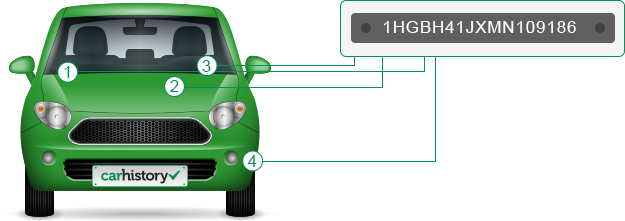
The vehicle identification number (VIN) is composed of 17 characters (digits and capital letters) that act as a unique identifier for the vehicle. A VIN displays the car's unique features, specifications and manufacturer.
The VIN can be found in a couple of places including on the car's registration label (1), on the compliance plate in the engine bay (2) or on the passenger side windshield (3), or on one of the door posts (where the door latches when it is closed) (4). See the image below:
Ready to take a closer look at that car you have your eye on? No one wants a car that comes with issues or one they paid too much for, so it’s important to give the car a thorough inspection. Whether you're buying from a dealership or a private seller, our tips will help you make an informed decision and feel good about your purchase.
Start by giving the car a thorough visual inspection so you can identify any potential issues early on. Things to look out for include:
Engaging a qualified mechanic to make an inspection can give you additional peace of mind. A professional will check the engine, transmission, brakes, suspension, electrical systems, and overall condition of the car. This can help uncover hidden problems such as mechanical issues, frame damage, or signs of poor maintenance, and allow the mechanic to give you an expert opinion on the quality of the car.
One of the most important steps when buying a used car is taking it out for a test drive. This helps you to get a feel for the car, see if it’s the right fit for you, and uncover any additional problems. When on the test drive:
A car history report gives you a comprehensive history report for the vehicle. It can help you identify any red flags or potential problems and could save you from buying a car with issues. The report includes details such as:
To check the car’s history, you need to obtain the Vehicle Identification Number (VIN). This unique code serves as the car's fingerprint and allows you to unlock information about its history.
Generally, private sellers offer lower prices, but they also come with more risks. Reputable dealerships will often thoroughly inspect the used cars they offer and may even organise repairs before making them available for sale. However, there are no guarantees, so it’s always important to carry out your own inspection.
Thorough inspections make for confident decisions. By following these inspection tips, you give yourself the best chance of buying the best possible car within your budget.